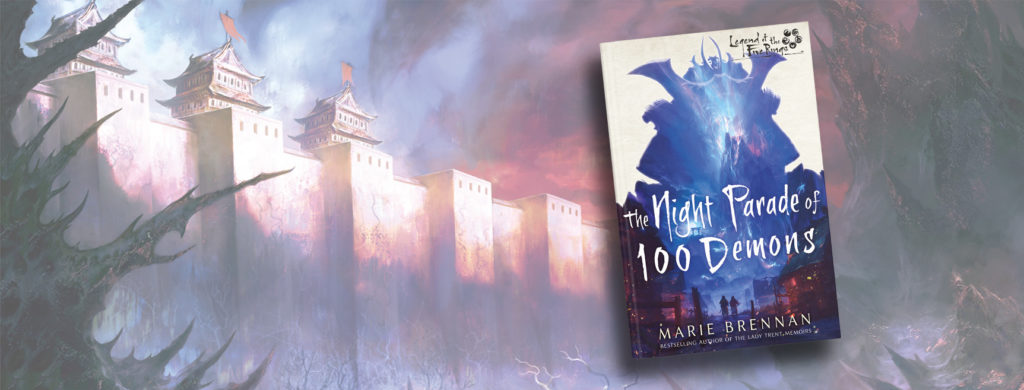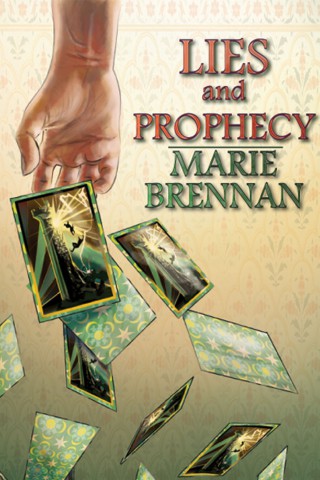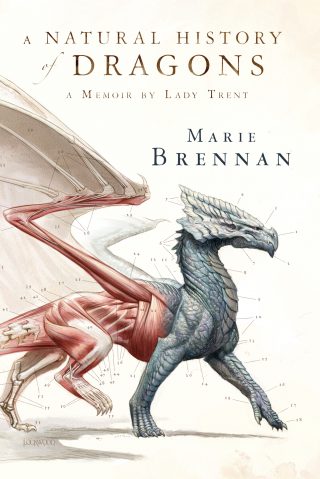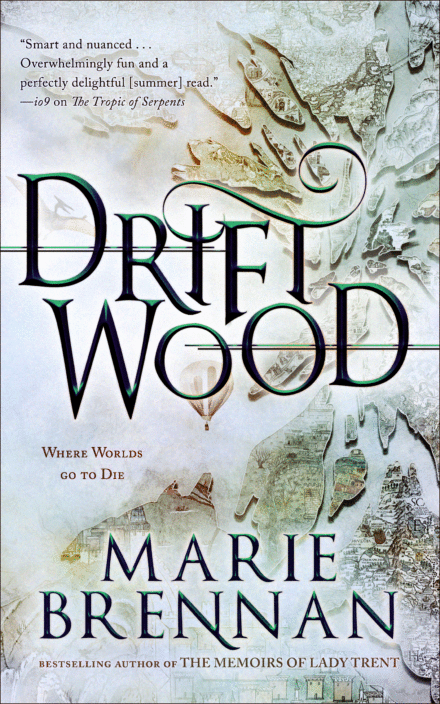The Night Parade of a Hundred Demons

We’re delighted to be the first to show the cover for Marie Brennan’s upcoming The Night Parade of a Hundred Demons, an upcoming L5R novel from Aconyte Books. Marie was also generous enough with her time to answer a few questions, so we have a fantastic interview below!
First look at the amazing cover for this book!


Marie Brennan is a former anthropologist and folklorist who shamelessly pillages her academic fields for material. She recently misapplied her professors’ hard work to Turning Darkness Into Light, a sequel to the Hugo Award-nominated series The Memoirs of Lady Trent. As half of M.A. Carrick, she is also the author of The Mask of Mirrors, first in the Rook and Rose trilogy. For more information, visit swantower.com, Twitter @swan_tower, or her Patreon.
For someone completely new to the Legend of the Five Rings settings, how would you describe it?
It’s a fantasy setting based on several periods of Japanese history, so that it encompasses warfare, courtly politics, religion, and (on the less directly historical side) supernatural creatures. Rokugan, the nation it takes place in, is divided into seven Great Clans who each have a very distinct personality. One of the things I love about the setting is that you can write a bunch of different flavors of story, or run different flavors of game, depending on which part of the setting you choose to emphasize.
How were you first introduced to the setting?
A friend of mine asked me to play in a game he was running. Prior to that point, I’d heard of L5R, but didn’t really know anything about it. I browsed through the fourth edition core book in my friendly local gaming store, really liked the look of it, and said sure, let’s give this a shot. Fast forward not a terribly long time, and I was engaged enough with the game that when AEG (who at that time owned the property) put out an open submissions call for chapters in the upcoming sourcebook Imperial Histories 2, I sent in two pitches and had one accepted — “The Togashi Dynasty” — so I went very rapidly from “uh, I’ve heard of it?” to writing for the game! And then I ran a campaign of my own later on.
David’s Curse of Honor served as an introduction to the setting and is a classic story of Samurai versus Monsters. Josh’s Poison River takes a very different direction with intrigue, conspiracy, and a mystery to investigate. What kind of story is The Night Parade of 100 Demons?
Amusingly, it’s sort of a combination of those two! My protagonists are investigating a mystery, but that mystery involves supernatural disturbances in an isolated mountain village, where yōkai — a broad term that encompasses a wide variety of folkloric critters — have been attacking during the full moon. The novel also has a romantic subplot, and some personal conflicts for each of the protagonists to sort through.
Your academic background is as an anthropologist and folklorist. In your book ‘New Worlds, Year One: A Writer’s Guide to the Art of Worldbuilding’ you offer advice to writers on how to draw on real-world inspirations to flesh out their worlds. What challenges have you found bringing real-life inspirations into fictional settings such as Legend of the Five Rings?
L5R carries a lot of baggage from its origins in the ’90s, when the approach was kind of “let’s grab a bunch of kewl Asian tropes and throw them into a blender!” The earlier editions of the game butchered the Japanese language and played up certain cultural aspects (like seppuku, ritual suicide) in a fashion that really wasn’t great. Fortunately FFG, the new owners of the game line, have been doing a lot to address some of those issues. There are still non-Japanese elements, but for the most part they’ve been introduced in a more coherent manner, so that they reflect the differences between the Great Clans rather than just being random. And the people at FFG are paying a lot more attention to how the culture is depicted, and whether elements like seppuku are being handled with appropriate consideration.
If I were building something like this from the ground up, there are still some changes I would make, like not using the names of real-world kami from the Shinto religion — L5R has a mix of real kami and invented ones, but the myths surrounding the real ones aren’t Shinto-based (in fact, one of the core stories is basically Cronus and Rhea from Greek mythology). But on the other hand, I’ve seen people complain that L5R mashes Sengoku-era warfare into Heian-style courtly politics and Tokugawa-era bureaucracy, and that one doesn’t bother me; I see it as just a way to make the setting flexible enough for those different styles of story I mentioned above. So I wouldn’t say that an invented setting needs to precisely replicate a specific period in all its particulars in order to pass muster.
Fundamentally, this is a really complex issue, and one that depends heavily on the details and the context. I’m very glad, though, that it’s more on people’s radars these days.
In Legend of the Five Rings, you are writing within an established setting. You already have several short stories, a novella, and now a book in the setting. How does that process work and were there any elements of the setting that you were able to flesh out?
Well, one element is right there in the title: the Night Parade of a Hundred Demons (the Hyakki Yagyō) is a concept from Japanese folklore that, to my great surprise, seems not to have ever been used in L5R before. So that’s something I got to add in! Anybody who recognizes that name will know the cause of the troubles my characters are investigating, but within the novel, there are reasons why they don’t immediately say “ah, this is what’s happening.” I also really enjoyed the chance to explore everyday life more than the usual game fictions allow for: those focus on samurai drama, since that’s the core of the game, but in the novel my two protagonists are the only samurai present for most of the novel. I liked the chance to put ordinary peasants in the spotlight for a bit, since let’s face it, that’s who most of us would be if we got transplanted to Rokugan.
When it comes to the game fictions, it’s a really interesting process that one of the writers — it might have been me; I honestly can’t recall — compared to things like the reality TV show Chopped. We get given a (metaphorical) basket with a few things in it, some characters and a general purpose the fiction is supposed to accomplish, but then it’s up to us to decide what dish/story to make with those ingredients. In the course of doing that, we have leeway to suggest things to the Story Team . . . most of which I can’t talk about, because they haven’t yet been revealed in the narrative! But I did get a lot of input before the game launched on the Perfect Land Sect, a splinter religious movement heavily inspired by Pure Land Buddhism, which is the source of a lot of controversy right now in Rokugan. (It plays a side role in the novel, too.) So it’s a fun situation for collaboration, where even though each of us is only writing a few thousand words here and there, we can actually have a surprising amount of influence on the setting and story overall.
This novel primarily features characters from two clans, the Dragon and the Phoenix, why did you pick these two clans to tell this story?
Remember above, where I said I browsed through the fourth edition core rulebook to figure out whether I’d want to play the game? I liked how each of the Great Clans had its own distinct flavor, and because I tend to enjoy mystical/spiritual things, I was immediately drawn to both the Dragon and the Phoenix. I wound up playing an ise zumi for that campaign — my handle on L5R fora is still Kinzen, after that PC — but I almost chose an Asako Loremaster instead.
When pitching the novel, there was a stretch of time where I was open to setting it wherever my editor wanted to explore, but for a mystical plot, those two made a lot of sense. I did wind up deciding to avoid the obvious thing, though; the shugenja in the novel is Agasha-trained, instead of me sending an Isawa in to deal with the problem. The Phoenix character is instead a loremaster — I haven’t lost my interest in that type!
What has been the biggest surprise or discovery for you in writing in the Legend of the Five Rings setting?
Honestly, I think it’s not anything in the setting itself; it’s how passionate and knowledgeable the fans are. L5R has a long history, so there are players and readers who have been around for decades. But they’re not just your usual sort of game grognards who can quote you cards and RPG rules from four editions ago; many of them also know quite a bit about Japanese culture and history and language. We wouldn’t get those arguments about “does it make sense to have Sengoku-style armies when a lot of the cultural elements actually date to the Tokugawa period” if they didn’t! I hang out on the official forum and the Discord, and I’ve learned all kinds of interesting details about not just L5R but also Japan through my interactions there. Which in general is one of the things I like about working on this setting: it’s a reason to go on learning more about a subject that’s intrigued me for over twenty years now.
What’s next?
I’ve written the ending of the novel in such a fashion that it leaves the door open for further adventures with these two characters, though as of yet there are no official, confirmed plans for a sequel. I’m hoping to spend more time with them, though! Apart from that, I have a non-L5R novel coming out in January of next year, The Mask of Mirrors, under the name M.A. Carrick (because it’s jointly written with my friend Alyc Helms, aka one of the players from the L5R campaign I ran a few years back).
You can read some of Marie’s L5R work in the below short stories or the Novella ‘The Eternal Knot’.

- The Rising Wave
- In the Garden of Lies (Part 1)
- In the Garden of Lies (Part 2)
- To The South (Part 1)
- To The South (Part 2)
- Snow And Sun
- Between the Lines
- Like Seeds on the Wind
- Two Swords Fall from Heaven
- Pine and Cherry Blossom
- What the Eye Cannot See
- Questionable Shelter
If you enjoy her writing, consider checking out some of her non-L5R work, a small fraction of which are below. For the full list see her website https://www.swantower.com
If you have any comments or feedback please post them in the comments section below. Check us out on the Imperial Advisor website, podcast, and YouTube channel for more discussion about the L5R LCG.







One Reply to “The Night Parade of a Hundred Demons”